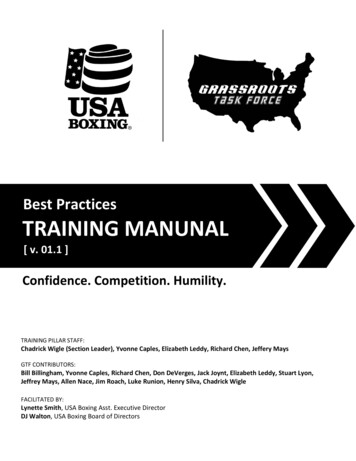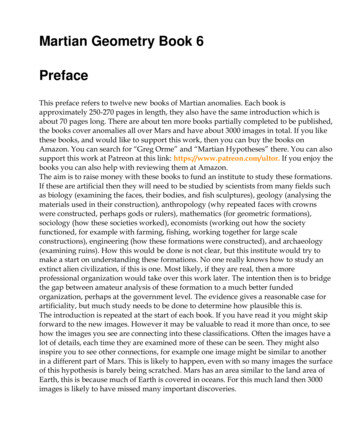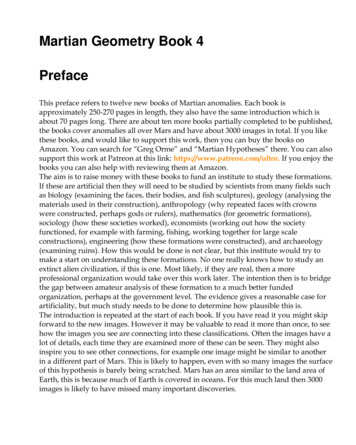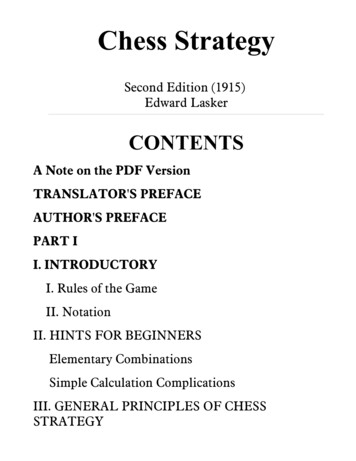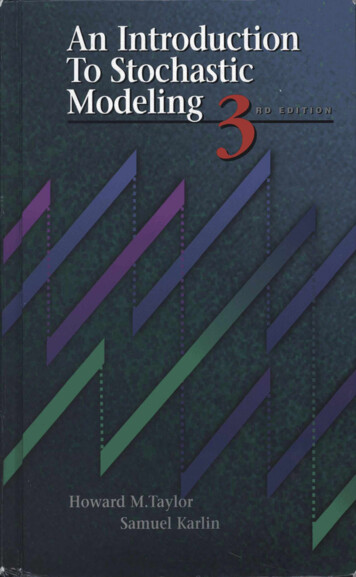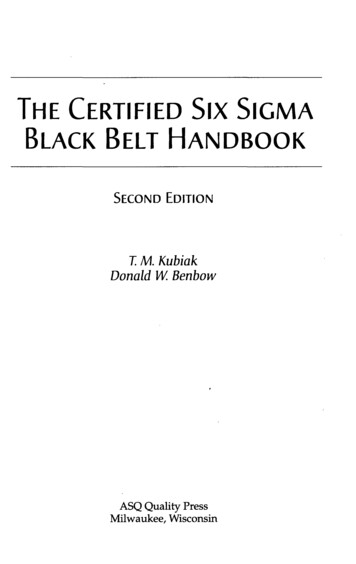
Transcription
section iv: punching basics27The JabPrefacEivWhy This Book?vsection I: becoming a college boxer2Sportsmanship2The Importance of Physical Conditioning3section ii: stance11Foot Position28The Power PunchStraight Right (Rear Hand) Punch30Left (Lead Hand) Hook32The Uppercut35section v: combination punching39SECTION VI: DISTANCE APPRECIATION43section viI: defense46Using the Hands12Blocks and Parries47Trunk PositionEvasive Action from the Waist13Head and Hand Position15SECTION III: footwork20Advancing21Retreating21Ducking and Slipping48Defensive FootworkBreaking Ground and Side Steps49section VIII: sparring51about usiba53Lateral MovementACKNOWLEDGMENTS2254Pivotingreference material2355
Before I could read, I started boxing lessons under the tutelage of myuncle, Pete Hobbie. This book is dedicated to him and his trainer, WilsonPitts.It is a compilation of all that I have learned throughout my eighteenyears of boxing training combined along with techniques from both men.Wilson not only taught and trained Peter Hobbie, but also the boxingpride of Richmond, Virginia, Carl “Piggy” Hutchins.Wilson lived in Philadelphia and studied boxing at Joe Frazier’s gym inthe 1970s. It was there that he learned and embraced the techniques of thelegendary trainer Eddie Futch. By watching and eventually being acceptedas a student of the sweet science by trainers such as George Benton, hewas able to learn boxing tactics and knowledge that are unfortunatelybecoming harder to find as time passes.Luckily, this manual helps preserve some of Pitts’ invaluable insight.Kevin FergusonFall 2014iv
In my experience as a collegiate boxer, visiting and training with variouscollegiate boxing teams, I found there are simply not enough coaches tofully assist beginners in mastering the essentials. It’s not uncommon toencounter one coach attempting to teach and train thirty or even fortyboxers. It is impossible to effectively teach at that teacher-student ratio giventhe time constraints and limitations inherent to a student’s many otherresponsibilities.This boxing instruction manual provides the basic, but proven,fundamentals of boxing and is meant to be a supplement to the studentboxer’s personal instruction. These techniques have stood the test of time, asmany of the descriptions and illustrations used can be found in boxing booksdating back to the beginning of the modern era of boxing1 and are still foundin boxing manuals today. The aim in creating this manual was to compilethe most useful elements of these classic methods in a comprehensibleand easily accessible manner.This manual will serve as a brief but inclusive boxing reference guide forhigh school or collegiate boxing clubs. We predict that it will find the righthome in the gym bags and lockers of amateur boxers and trainers across thecountry.Footnotes1 In 1867, the Marquess of Queensberry rules were introduced in England. Theserules provided the landscape for modern boxing rules and regulations.v
TrainingTraining is essential for the amateur boxer to cultivate a fit body and mind,as both are necessary to succeed in the sport. It is not sufficient for a boxerto pursue only the development of technical skill, for boxing requires amultidimensional athlete.Stamina is needed to maintain efficacy through the progression of rounds,speed is needed for punching and defensive maneuvers, and power isneeded for explosive movements of the core and feet. A boxer needs not onlythis, but a sharp psychological state to withstand and overcome the manyobstacles that will be posed throughout his or her progression. All of this isaccomplished through the rigors of disciplined training.A complete boxing training regimen is comprised of the following: adynamic warmup, cardiovascular training, plyometrics training and skilltraining. This diversity of exercises not only builds the physical attributesneeded in the ring, but also works to improve mental focus. For this reason,a boxer cannot neglect any aspect of training and should strive to make themost of each workout.23
Before anything else, general mobilityand power-to-weight ratio should beaddressed by training the boxer’s lowerbody and core. Start with unweightedsquats and lunges, rope skipping, andstep-up aerobics. Boxing is intervaltraining: you do an exercise to rapidlyraise the heart rate, stop for recovery,and then repeat. It’s the trainer’s jobto adjust the number, duration andintensity of intervals. This style ofcoaching tipsCOURTESY OF WILSON PITTS training will help to burn fat and increaseleg strength; both are needed and shouldbe achieved before the gloves are everput on. (Depending on the beginner’sstarting fitness level, this could take a fullsemester.)Once general conditioning andimproved mobility is gained, resistanceand plyometrics training, using weightsand plyo-boxes, can be introduced. Startby marking a line on the floor with tapeand have the boxers jump over the lineside to side while maintaining balance.Next, using plyo-boxes, introduce boxjumps. (The height of the box should notexceed six inches.) Resistance trainingcan be integrated into these exercises byadding light dumbbells or flexion bands.This phase of training is aimed atstrengthening the connective tissueenough to avoid knee injuries. Mygolden rule is to never jump on concrete.The shock created by continuous hardimpact can be detrimental to connectivetissues and joints. If necessary, build aplywood-topped surface to jump on.Remember, all movements should targetthe core or hips area.4dynamic warmupA dynamic warmup prepares the body for the demands of a workout byeliciting the acute physiological changes that prepare the boxer for strenuousphysical performance. These physiological changes include an increased heartrate, increased respiratory rate, increased blood flow to large and small musclefibers, increased core temperature, and enhanced muscle elasticity to aid inthe prevention of injury during explosive movements.To achieve optimal benefits, the warmup exercises should emulate, asclosely as possible, “real boxing” movements.See Figure 1 below for an example dynamic warmup.Figure 15
cardiovascular trainingCardiovascular training (sometimes abbreviated to cardio training) isperhaps the most important aspect of any boxer’s training regimen. Inamateur boxing, lack of physical fitness probably causes more losses than anyother factor. Too often, collegiate level amateurs rely solely on the mandatoryclub practices for workouts and do not supplement those workouts bytraining on days that the team does not meet. This is at least partly due to thebusy lifestyle of most collegiate boxers. Between the rigors of class and schoolrelated obligations, training and recovery time is always at a premium. Forthis reason, the collegiate boxer must train intelligently to budget both a busyschedule inside and outside of their program.See Figure 2 for an example of a cardiovascular program.Make no mistake, building a strong cardiovascular system requires asteadfast commitment. There is, however, a notable distinction betweenhard work and efficient work. There is a quantitative metric, known as theTarget Heart Rate Zone, that can be used to ensure that you are workinghard enough to achieve benefits without overworking and risking injury orburnout. Training below your target zone may not be intense enoughto burn sufficient calories or improve your cardiovascular fitness, whiletraining above your zone means you’re working above your threshold forrecovery.Use the chart (Figure 3) below to determine your individual target zone.Figure 2Figure 367
plyometrics and resistance TrainingPlyometrics training, often referred to as jump training, is a trainingtechnique designed to increase explosive muscular power and permit fasterand more powerful athletic movement. This is achieved by conditioning theneuromuscular system with a wide variety of dynamic resistance exercisesthat rapidly stretch a muscle (to reach its eccentric phase) and then rapidlyshorten it (to reach its concentric phase). A well-designed program willtypically modify and make use of bounds, hops, jumps, leaps, skips, swings,and twists. Because plyometric exercises are modified to closely mimicthe motions used in the boxing ring, these basic movements enhance anathlete's ability to rapidly change direction, body motion, and position,thus increasing speed and power.Although plyometrics fit the power training description required forboxing, plyometrics exercises can place a great deal of stress (especiallyfor beginners) on joints and connective tissue if not properly performedand supervised. For this reason, it is important to design a programthat gradually increases in difficulty, as well as adapts to each athlete'sindividual capabilities.See Figure 4 below for an example of an introductory plyometrics routine.skill developmentcoaching tipsCOURTESY OFWILSON PITTSAll boxing skills should be learnedand practiced in slow motion first. Skilltraining should be light and easy. Thismeans the following: there should be nothreat of getting hit, no complicateddrills that might frustrate a beginner,and no practicing skills after the boxeris tired.Make a separate time for more generalconditioning. The coach’s job is tobuild confidence while teaching thefundamentals in an organized manner.I firmly believe that an early masteryof the fundamentals will help to preventinjury, and thus greatly improve theoverall boxing experience. It is highlylikely that few of these young people willactually box for more than a few years.But if they have a positive experience, thecharacter-building aspects of overcomingfear, self-discipline, and leadership will lasta lifetime.Figure 489
In the sport of boxing, the fundamental principle is to hit and not gethit. To be sure this occurs, this requires perfect bodily balance. Balance isessential for a fighter to achieve maximal coordination of the hands andfeet. Proper stance must be developed in order to achieve a seamless andefficient flow between offensive and defensive movements. Mastering therudiments of proper form is the most essential step for any prospectiveboxer. It must be diligently practiced until the posture becomes “secondnature.”Proper foot position, trunk position, head position, and hand positioncomprise the Fundamental Boxing Position. It is imperative that anyamateur boxer learns this as naturally and precisely as possible for maximumperformance.11
To begin, one must first study the classic foot position.To start, stand naturally with both feet spaced approximately shoulderwidth apart. The toes should be pointed directly forward so that the feetare parallel. With the non-dominant foot, take one step, the size of anatural walking gait, directly forward. Next, make a slight inward turn(approximately 45 ) of the lead leg and foot. This lead leg should be straight,neither locked nor bent. Maintaining this foot position, lift the right heel offof the ground and bend the right knee.See Figure 5 for an example of proper foot position.Figure 5Coaching TipOnce this basic position is established, stability tests should be used toensure adequate balance. To test for a solid foot position, a partner or coachshould administer a light, quick shove to the front of the boxer. If the pushcauses the boxer to fall backward, proper footing has not been established.Additionally, lateral stability can be confirmed, in this stance, by bendingforward at the waist and shifting the weight of the upper-body from sideto side. This simple drill is aimed at replicating the constant transference ofweight from one leg to the other that is required for effective combinationpunching.12The position of the trunk is mainly determined by the position of the leadfoot and leg. In other words, if the lead foot and leg is in the correct position(as described in the above section), than the trunk should automaticallyfollow suit. Because of this correspondence, it is of the utmost importancethat the lead foot and leg be slightly inwardly turned, mainly for defensivepurposes.This slight inward turn of the trunk produces a natural and rather desirabledefensive advantage: it presents a more narrow target to the opponent. Thisdefensive advantage is best appreciated when compared to the alternativeposture that would follow from a lead leg and foot that is rotated outward.In the case of an outwardly turned lead leg and foot, the body becomessquared toward the opponent, and as a result, a larger, more exposedtarget is presented. The latter, more defensive-oriented posture is moreprudent, especially for the novice, hence its longstanding recognition as thefundamental, orthodox trunk position. More plainly, this position gives aboxer the best chance at realizing the golden rule of boxing: to hit and not behit.To help illustrate this point, it might proveuseful to take a look at the former four-weightdivision world champion and legendary boxer,Pernell “Sweet Pea” Whitaker. Whitaker wasan esteemed defensive mastermind, alwaysplacing the highest premium on avoidingunnecessary damage. He was a slippery, hard-tohit counter-puncher whose success in the ringdemonstrated the importance of learning andmastering defensive fundamentals. Whitaker’sdefensive prowess was unmistakably relatedto his adoption of a classic defensive posture.Whitaker kept his lead foot and trunk turnedinward, narrowing his target body, thus leavingas little as possible unguarded and in range ofhis opponent.13
Undoubtedly, Whitaker was a highly gifted athlete with speed and keenreflexes among many other desirable attributes at his disposal; however, thispoint should not deter or detract from the intended lesson.Remember, in the sport of boxing, it is not always the more naturallygifted fighter that wins the day.A Tip For Taller BoxersGenerally, the advantage of theorthodox trunk position is mostevident when adapted by taller,longer fighters. The inwardlyturned trunk makes the best useof a taller boxer’s height and reach.Along with reducing the size of aboxer’s unprotected area, a moresideways stance naturally leaves thelead hand closer to its target and,in turn, allows a taller fighter tokeep a shorter one at a favorabledistance. At the same time, thismore sideways posture enablesattack and counterattack withboth hands while maintainingdefensive integrity.More on distance to come in alater section.The last, but surely not the least, aspect of the Fundamental BoxingPosition to be covered is the placement of the hands and head. Thispositioning is vital as the hands are the tools of the boxing trade and the headis the predominant target. It is, therefore, essential that boxers of all skilllevels effectuate the core elements rooted in these time-tested fundamentals.ORTHODOX HAND POSITION(ON-GUARD)LEAD HAND AND ARMIn the on-guard pose, the hands and armsare arranged to provide maximal defensiveprotection while still permitting a seamlesstransition to offensive attack. In the properfooting, hold your lead hand up with theelbow bent and resting on the short ribs toprotect the body. Carry the fist about eightinches from the lead shoulder at approximatelyshoulder-height and off to the left (or to theright if left-handed) as far as possible withoutraising the left elbow. Your arm and handshould be relaxed, with the tricep muscleresting on the latissimus muscle (your rib cage)and the hand in a loose fist. It is important thatyour hand is turned so that the thumb faceseither upward or inward. (See Figure 6.)Figure 6Right hand and armBring your rear fist up to about the level of the chin while keeping theelbow close to the body. The fist is used to protect the chin while the elbowand forearm are used to protect the right side. The arm should be relaxed andready to make either an offensive or defensive movement. (Again, seeFigure 6for an example.)1415
Head PositionFor all intents and purposes, inboxing, the head is regarded as if it werea part of the trunk, thus it should notmove indepently of the body. Dropthe chin down so that it is pinnedtightly down to the breastbone and lookthrough the top of the eyes. (See Figure7 for an example.)In this position, the muscles andbone structure of the neck are alignedto withstand and absorb an oncomingblow. Because only the top of the headis exposed, it is extremely difficult foran opponent to land a punch on thechin or jaw. Accordingly, proper headposition must be maintained underall circumstances, no matter how thebody shifts. If the body turns to theright or left, the head should movecorrespondingly.John J. Walsh, the winningest coachin college boxing history, wrote thefollowing about the importance ofproper head position:“One of a coach’s biggest jobs is toconvince a boy that his chin must bekept down, or he may find himselfon the canvas. I have had nationalchampions, who, after four years ofcollege boxing, still made the mistakeof dropping their shoulders and puttingtheir chins up."22 Walsh, J. J. (1951). Boxingsimplified. New York: Prentice-Hall.Overview of the Fundamental Boxing Position:Figure 7John J.Walsh16Although this stance will almost certainly, at first, feel unnatural oruncomfortable, these fundamentals must be diligently drilled into a noviceboxer until little to no effort is required to assume the Fundamental BoxingPosition. This is not to say that all boxers should adopt the same on guardstance. Rather, there are certain unquestionable basics that, if adequatelygrasped, will ensure efficacy in the ring. As experience is gained, thesebasics should serve as a solid foundation from which adaptations that bestcomplement individual strengths can be made.The great undefeated former HeavyweightChampion Rocky Marciano once wrote:“You can't judge an advanced boxer'sstance by how close it is to pose position.Some “pros” appear to be doing everythingwrong. They practically fight with their handsdown. This may give the impression thatthese fighters are “wide open.” But with theproper footwork, timing, and experience, theunorthodox boxer or unnatural boxer canavoid a good deal of punishment, while hedraws an unwary opponent in, keeps himoff balance, and counter punches him withunerring accuracy. It takes years to developthis kind of ability, however. A beginner mustRocky Marcianostart with the pose position. It will be wise tolearn it thoroughly, since it is the foundationof any boxing course.”things to remember about the fundamental boxing positionStay relaxed!Find your balance.Keep your knees flexed slightly.Keep your hips and shoulders parallel to the ground.Your body should be bent forward slightly at waist.Your non-dominant hip and shoulder should be forward.Your chin stays down on the breast bone.Look out of top of your eyes.Your lead hand is held high at shoulder/eye level.Your rear hand is held in and level with chin.Your elbows are held in to your ribs.17
the fundamental boxing positionCOACHING TIPS1. The lead foot is turned in at anangle of approximately forty-fivedegrees.2. The right heel is raisedapproximately two inches off thefloor.3. Both knees are slightly bent.4. The body weight is eitherbalanced between both legs or shiftedslightly to the rear leg.5. The elbows are down and infront of the short ribs.6. The lead hand is held betweenshoulder and eye height about eightto ten inches in front of the bodyand off to the left (off to right if lefthanded) without sacrificing elbowpositioning.7. The rear fist is relaxed and heldat jaw level with thumb inward.8. The chin is tightly tuckedforward to the breast bone.9. Avoid tightening or clenchingthe shoulder and arm muscles.10. The boxer should feel relaxedyet poised to strike, cultivatinga “springy” feeling as if ready topounce.18
Once a proper stance has been established, the next step is to mastermoving in any and all directions while maintaining foot movement aimed atkeeping, as closely as possible, to the precept of perfect balance that was sohighly stressed in the development of a good stance. Essentially, this meansthat when one foot moves, the other should follow closely behind. (The feetshould be neither closer together nor farther apart than they are when theproper stance is taken.)At its most basic, footwork can be defined as the use of the feet to movethe body so as to be in the best position for attack or defense. This shouldnot be confused with and does not mean jumping around, nor does it meanmovement for the sake of creating a spectacle. Rather, footwork meansmoving just enough to accomplish a purpose: to make an opponent miss, orto deliver a counter blow effectively.At no time, in his or her movement, should the boxer›s balance becompromised. Sustaining a balanced, on-guard position after everymovement allows a boxer to take any action at any given time withouthesitation. If a compensatory adjustment must be made before taking or astep or throwing a series of punches, that is an indication of deficient balanceand thus improper footwork.This section will provide the four most fundamental foot movements:advancing, retreating, lateral movement, and pivoting. Remember thata true master of footwork can move in any direction, while rarely using thesame move consecutively. It is of little worth to solely practice moving in anyone direction.Core Concepts ofFootwork1. Move feet closest to the directionin which you want to move first.2. Shuffle rather than jump or hop.3. Circle away from your opponent’s“power hand” (their rear hand).4. Practice moving in and out.5. A moving target is not easily hit.6. Move in every time you punch.A forward advance uses series of small shuffle-like steps to move forwardin order to minimize the need for wide steps and major weight shifts duringwhich balance is precarious. This means the aim is to maintain balance bykeeping the feet, at all times, directly under the body. When advancing, thebody should be poised to execute either an offensive attack or a defensivemaneuver. The key is the maintenance of the Fundamental Boxing Position atall times. (Refer back to Figures 6 and 7 for examples of this.)A Guide to the Forward Advancefrom the Fundamental Boxing PositionPushing off with the ball of the back foot,slide the front foot forward with the backfoot directly following.The back foot should move forward thesame distance that the front foot was moved.For example, move the lead foot forward twoinches, followed directly by the back foot,moving it two inches forward.One foot should be in contact with thefloor at all times.Momentum is regulated by the push of theback leg.Remember, do not hop.RetreatingRetreating, or moving backwards, employs the same functional principlesas when advancing. However, when retreating, the rear foot must movefirst. Once again, for the purpose of sustaining perfect balance, both feetmust be kept under the body at all times.2021
Lateral movement, or moving left and right, is an especially importantskill for the amateur boxer and is often one of the key points that caninfluence the outcome of a bout. To the trained eye, a boxer with the abilityto move laterally effortlessly, without compromising balance, stands out aspossessing a particularly advantageous skill. The highly esteemed coach of the1976 United States Olympic Team, Pat Nappi, expressed his regard for theimportance of lateral mobility when he said “lateral movement.was the keyto our success in Montreal.” For the especially keen eye of Nappi to makethe attribution of his team’s success to lateral movement should underline itsimportance.Generally, it feels less natural and more difficult for a right-handedboxer to move to the right and a left-handed one to move to the left. Thisinitial awkwardness, however, must be overcome through practice, for thecapability to move to the right as well as to the left with equal readiness isparamount to both styles. Mastering this skill allows a boxer to quickly evadeincoming punches while simultaneously setting up his or her own attack orcounterattack from a different angle.For more on angles and spacing, see Section IV.The Primary Elements of LateralMovementThe pivot is an essential boxing movement; yet, perhaps due to itssimplicity, is too often overlooked and underemphasized by aspiring amateurboxers. The usefulness of the pivot applies to both defense and offense:on offense it can be used to change the angle of attack while throwing acombination of punches, and on defense it can be used to escape a forwardcharging opponent, or in conjunction with a duck.To pivot, keep your lead foot planted as you lift your rear foot and spinaround to the left or right. It might help to imagine that your lead foot ispinned to the ground and can only be rotated like the hands of an analogclock. By changing the orientation of your body without giving up groundwith your lead foot, you are able to move from directly in front of youropponent while still remaining in range and at the same distance. (See Figures8-11 below.)the primary elements of the pivotFrom the proper stance, spin your front foot on the spot and allow yourback foot to lift.Keep your lead foot in place by spinning on the ball of your foot.Allow the rear foot to lift and spin with your body to the right or left(depending on which direction you intend to pivot).Maintain your stance and keep your weight evenly distributed.From the Fundamental Boxing PositionMoving to the left, your left foot leads.Moving to the right, your right foot leads.Only a few inches are covered at a time, withyour trailing foot snapping back into positionand retaining complete balance.Keep your feet close to the floor. Think slidingrather than hopping.2223
LEFT PIVOTright PIVOTFigure 8Figure 10Figure 9Figure 112425
Since the fundamental principle of boxing is to hit without being hitin return, hitting is the foundation of boxing. Indeed, a boxer that hasdeveloped the ability to hit hard and with speed has, already, an inherentadvantage when it comes to preventing an opponent’s attack. A boxer mustbuild a strong foundation by learning to deliver the basic punches of thegame with the utmost proficiency.In boxing, punching proficiency can be defined as the ability to hit hardand fast with minimal effort, and without disturbing bodily balance.It should be the goal of every amateur boxer to practice each of the basicpunches until he or she is comfortable using either hand.27
The Primary Elements of the JabFrom the on-guard positionThe jab, although not considered a power punch, is the most importantpunch in amateur boxing. It should be properly mastered, spending as muchtime on its development as necessary before moving on to the other punches.Indeed, its importance cannot be stressed enough, as it serves a varietyof uses. It is an offensive tool that can keep an opponent off balance andpreoccupied. (See Figures 12-14 for examples.)Uses of the jabFigure 12As a rangefinder: If you can reachyour opponent with the jab, they are inrange for other subsequent punches.To keep opponent off balance: Asolid jab delivered to an opponent’sbody or head can disorient their plan ofattack by disturbing their balance.As a primary scoring punch: Becausethe jab is the fastest and most directroute to an opponent’s target area, it isthe chief way to score points in a match.To create openings for the rearhand: Your opponent’s reaction to theincoming jab often creates an openingfor a quick follow-up straight rear handpunch (which is explained in a latersection).To give the opponent little timeto react: A jab can preoccupy youropponent leaving them vulnerable andwith little time to react to follow-uppunches.The lead fist should snap out straight from the shoulder, with no otherpreliminary movements to attempt to “put something extra” on the punch.The elbow folds, like a hinge, and remains pointing toward the ground (andnot flaring out to the side).The snap of the jab comes from the whiplike motion of the forearm andfist, as well as the snap of turning the hand a quarter turn so that the back ofthe hand is upward and the palm down is facing down.The jab, and all punches for that matter, are not pushed. They are deliveredsmartly with precision and snap.At the very least, a good jab will disorient and preoccupy your opponentwith defensive concerns and possibly discourage him from stepping into itsrange.After landing, the lead hand returns as quickly as it releases, along exactlythe same path, to the on guard position.The rear hand remains in the on guard position. Don’t drop your hands.Only after mastering a “snappy” jab straight from the shoulder without anyturning of the shoulders or body should the boxer experiment with steppingin with the jab, or using a slight shoulder rotation to accentuate the impact ofthe punch.Figure 1328Figure 1429
The straight-right (also known as the rear-straight or rear hand) is theprimary power punch and is generally most effective following the jab. Aforceful right hand starts by converting the potential energy, afforded by theguard stance, to set off a perfect flow of energy through the entire body. Thistransference of energy through the body is called kinetic linking.Much the same as a sprinter exploding off the starting block, the rear footdrives into the ground and, like links in a chain, the generated energy travelsup the leg, twists through the hips, and moves into the large muscles of thechest, back and shoulders. Comparable to the coiling and cracking of a whip,the energy for a straight rear hand multiplies through leverage as it flowsthrough the body, travels out the arm and fist, and snaps into the opponent.After all, boxing is called the Sweet Science!For clarity, it might be helpful to think of the fist as simply a tool ofdelivery, with the power developed during the explosive body movement.More plainly, it is a coordinated, full-body movement that gives power to thepunch. An effective blow is snapped out and not pushed. (See Figures 1518 for examples
years of boxing training combined along with techniques from both men. Wilson not only taught and trained Peter Hobbie, but also the boxing pride of Richmond, Virginia, Carl “Piggy” Hutchins. Wilson lived in Philadelphia and studied boxing at Joe Frazier’s gym in the 1970s. It was
